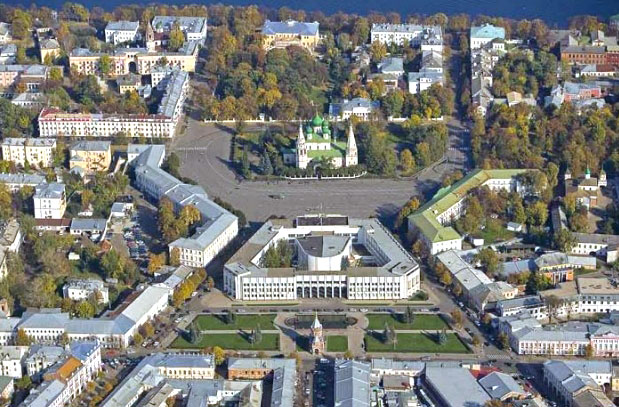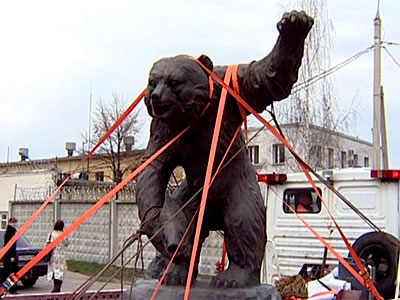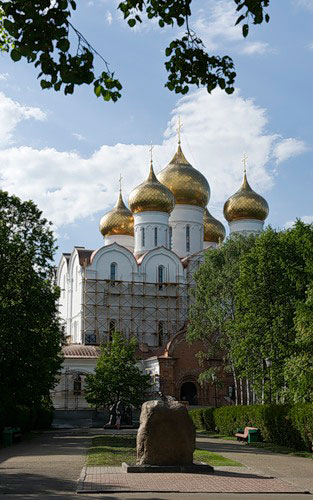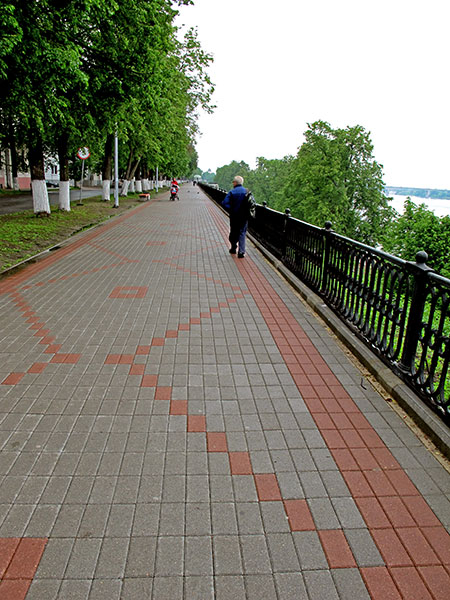
Yaroslavl to Celebrate First Millennium in 100 Days
/ Главная / Russkiy Mir Foundation / Publications / Yaroslavl to Celebrate First Millennium in 100 DaysYaroslavl to Celebrate First Millennium in 100 Days

Yaroslavl prepares to celebrate the 1000 anniversary of its founding. And this won’t be an easy task – the city has 100 days left to spend 28 billion rubles allocated by the federal government to set things in order for the event. Municipal official’s summer holidays have been cancelled and construction and restoration work is evident throughout the city. The fruits of these efforts will only be apparent in September, and for now many places in the center resemble construction sites.
It is expected the President Dmitry Medvedev will come to Yaroslavl to participate in the celebrations, which are planned for September 10-12. In some ways this will not only be an inspection of the work of local officials, but also that of the federal government, as President Medvedev himself has headed the state commission in charge of preparing for Yaroslavl’s 1000-year celebrations. And there is ample reason to praise the federal government, which provided a substantial sum for this event. On road improvements alone, the government allocated more federal funds than it had over the past 20 years combined.
Tourist will likely be interested in knowing that new hotels are being built, old ones refurbished and the Volga embankment – one of the prettiest in Russia already – is getting an overhaul. The confluence of the Volga and Kotorosl – the site where the city was founded – will now have a new monument dedicated the 1000th anniversary. And of course such an event couldn’t take place without the participation of sculptor Zurab Tsereteli, who created the surprisingly modestly sized symbol of city – a bronze bear – which will be erected in “1000th Anniversary Park”. The image created by the sculptor is, like many of his works, quite original. Yaroslavl’s coat of arms depicts a bear with an axe. According to local legend, when Grand Prince Yaroslav the Wise founded the city, he killed a bear set upon him by the local pagans. The bear in Tsereteli’s sculpture is for some reason… fishing.

It would be appropriate to note that tourists are most attracted to Yaroslavl for its historic city center, which is comprised of 110 hectares and 150 or so monuments. The city center was included in UNESCO’s world heritage list in 2005. However, not all is as well as it may seem at first glance.
In 2008 at a joint meeting of the Russian Academy of Architecture and Construction Sciences and the Commission on Preservation of Historic Heritage, Restoration and Reconstruction of the Russian Architects Union, the plans for the construction of a new Cathedral of the Assumption of Our Lady came under severe criticism. Specialists were concerned that the new cathedral would be 12 meters higher than the historic cathedral built in 1659 (and destroyed in 1937). Adding fuel to the fire, the plan to rebuild the cathedral as an exact copy of its historic predecessor was rejected, and the new plan was accepted only a month and a half after the city had been included in the UNESCO list.
The construction of this building, which according to experts and public opinion disrupts the historical silhouette of the city, along with other construction projects within the historic center, attracted the attention of UNESCO. The city risked losing its newly acquired status. However, the Yaroslavl delegation to a meeting of the UNESCO world heritage committee meeting in June 2009 managed to successfully defend the city’s plan, although not without criticism. The committee expressed its serious concerns about the abovementioned issues. But Yaroslavl’s city officials have a different take on the situation.

According to Mayor Andrei Zharov, “All issues concerning the construction of the new cathedral have been resolved.” “In comparison to the previous cathedral, which functioned when the 300,000 people lived in the city, the new cathedral is larger, but the city’s population is now around 600,000. It can hold up to 2000 people. It is no so large in comparison to the Qol
It’s unlikely that all of this confusion will prevent Yaroslavl from remaining on of the most attractive spots for tourists in Russia. Here you can find a unique atmosphere of a medieval city that long ago was lost in the metropolitans of the world. Every year they hold a “Man of Labor” competition in which they select the best chemist, best teacher, best mechanic… Try to image such a contest in Moscow.
The future development of the city is worth discussing now. Yaroslavl evokes a sense of relative prosperity but at the same time generates a feeling of being locked in time. It’s no coincidence that the city’s population has gone neither up nor down over the past decade. Some tourists from Moscow feel that the city is lacking “drive” while others to the contrary are drawn to the provincial tranquility of the city. Life is rather comfortable here, but it’s difficult to say what ambitious people would have to do here.
Are the residents of Yaroslavl content with the good provincial town status of their city? To begin with, Yaroslavl is rather large and, with its tourism potential and proximity to Moscow, is a rather appropriate candidate, for example, to become a center of modern art. Why not try? After all, until the end of the 18th century, Yaroslavl was the second largest and wealthiest municipality in Russia after Moscow.
The Yaroslavl’s authorities have selected a course of development that is both wise and conservative: to renew and improve, i.e., to create the lacking elements of normal city infrastructure. However, following the anniversary, it probably would be good to consider how to further develop tourism and the city itself as a cultural center. Should new formats be sought and new efforts made? What vision do the residents and authorities themselves have for the city? These questions will have to be addressed was the celebrations have concluded.
New publications

 Mikhail Kalatozov, a director who transformed the world of cinematography in many ways, was born 120 years ago. He was a Soviet film official and a propagandist. Above all, he was capable of producing movies that struck viewers with their power and poetic language.
Mikhail Kalatozov, a director who transformed the world of cinematography in many ways, was born 120 years ago. He was a Soviet film official and a propagandist. Above all, he was capable of producing movies that struck viewers with their power and poetic language.  Ukrainian authorities have launched a persecution campaign against the canonical Ukrainian Orthodox Church (UOC), the biggest one in the country's modern history. Over the past year, state sanctions were imposed on clergy representatives, searches were conducted in churches, clergymen were arrested, criminal cases were initiated, the activity of the UOC was banned in various regions of the country, and monasteries and churches were seized.
Ukrainian authorities have launched a persecution campaign against the canonical Ukrainian Orthodox Church (UOC), the biggest one in the country's modern history. Over the past year, state sanctions were imposed on clergy representatives, searches were conducted in churches, clergymen were arrested, criminal cases were initiated, the activity of the UOC was banned in various regions of the country, and monasteries and churches were seized.  When Nektary Kotlyaroff, a fourth-generation Russian Australian and founder of the Russian Orthodox Choir in Sydney, first visited Russia, the first person he spoke to was a cab driver at the airport. Having heard that Nektariy's ancestors left Russia more than 100 years ago, the driver was astonished, "How come you haven't forgotten the Russian language?" Nektary Kotlyaroff repeated his answer in an interview with the Russkiy Mir. His affinity to the Orthodox Church (many of his ancestors and relatives were priests) and the traditions of a large Russian family brought from Russia helped him to preserve the Russian language.
When Nektary Kotlyaroff, a fourth-generation Russian Australian and founder of the Russian Orthodox Choir in Sydney, first visited Russia, the first person he spoke to was a cab driver at the airport. Having heard that Nektariy's ancestors left Russia more than 100 years ago, the driver was astonished, "How come you haven't forgotten the Russian language?" Nektary Kotlyaroff repeated his answer in an interview with the Russkiy Mir. His affinity to the Orthodox Church (many of his ancestors and relatives were priests) and the traditions of a large Russian family brought from Russia helped him to preserve the Russian language.

 The leaders of the Friends of the Great Russia cultural association (Amici Della Grande Russia) in Italy believe that the Western policy of abolishing Russian culture in Europe has finally failed. Furthermore, it was doomed to failure from the beginning.
The leaders of the Friends of the Great Russia cultural association (Amici Della Grande Russia) in Italy believe that the Western policy of abolishing Russian culture in Europe has finally failed. Furthermore, it was doomed to failure from the beginning.  Name of Vladimir Nemirovich-Danchenko is inscribed in the history of Russian theater along with Konstantin Stanislavski, the other founding father of the Moscow Art Theater. Nevertheless, Mr. Nemirovich-Danchenko was a renowned writer, playwright, and theater teacher even before their famous meeting in the Slavic Bazaar restaurant. Furthermore, it was Mr. Nemirovich-Danchenko who came up with the idea of establishing a new "people's" theater believing that the theater could become a "department of public education."
Name of Vladimir Nemirovich-Danchenko is inscribed in the history of Russian theater along with Konstantin Stanislavski, the other founding father of the Moscow Art Theater. Nevertheless, Mr. Nemirovich-Danchenko was a renowned writer, playwright, and theater teacher even before their famous meeting in the Slavic Bazaar restaurant. Furthermore, it was Mr. Nemirovich-Danchenko who came up with the idea of establishing a new "people's" theater believing that the theater could become a "department of public education."  "Russia is a thing of which the intellect cannot conceive..." by Fyodor Tyutchev are famous among Russians at least. December marks the 220th anniversary of the poet's birth. Yet, he never considered poetry to be his life's mission and was preoccupied with matters of a global scale. Mr.Tyutchev fought his war focusing on relations between Russia and the West, the origins of mutual misunderstanding, and the origins of Russophobia. When you read his works today, it feels as though he saw things coming in a crystal ball...
"Russia is a thing of which the intellect cannot conceive..." by Fyodor Tyutchev are famous among Russians at least. December marks the 220th anniversary of the poet's birth. Yet, he never considered poetry to be his life's mission and was preoccupied with matters of a global scale. Mr.Tyutchev fought his war focusing on relations between Russia and the West, the origins of mutual misunderstanding, and the origins of Russophobia. When you read his works today, it feels as though he saw things coming in a crystal ball...